Technical hygiene of a website means the world when you’re growing traffic volumes, aiming for reaching a better SERP position or turning a profit with advertising. A 404 error cannot turn your SEO and monetization down to zero, however, if search engines detect too many of those, it can be harmful. In today’s post, you will learn what 404 error codes are and how to find and fix them in a most flawless and practical way. So let’s begin.
Content
- What is a 404 error?
- Why are 404 errors bad for websites?
- How to find and fix 404 errors on your site
- How often should you check for 404 errors?
- Why should you personalize your 404 page?
- Conclusion
What is a 404 error?
When a user enters a page’s URL into the browser search bar, the browser identifies the server that houses this page. It then sends the server a request to obtain all the webpage’s files, necessary to display it to the user. When the page is loaded on the user’s device, the HTTP header displays the status code of the server’s response. This user rarely sees this status.
There are 5 types of HTTP response status codes. They indicate how successful a particular HTTP request was:
- 100–199 Information answers.
- 200–299 Successful answers.
- 300–399 Redirects.
- 400–499 Client or Request errors.
- 500–599 Server errors.
If the request is correct, and the requested page indeed exists, then a response will be received with the code 200, and the user will be shown the page they requested. But if something went wrong, the error information will appear.
So what is “Error 404?” It is client or request error. The 404 Not Found is a server response code that indicates that the page requested by the user does not exist on the server. The user follows the link to the page, but fails to find the necessary information. They could leave the page unless you make them stay offering helpful content or clues.

Hard vs. Soft 404 Errors, what’s the difference?
What does Soft 404 mean? When a Soft 404 error happens, the server sends a “200 OK” status. But Google isn’t satisfied with such an answer. According to Google, the page’s content looks like a 404 error. Usually, pages with Soft 404 errors are non-existent ones or ones that have been deleted but still remain part of the search engine for some time.
The server’s “200 OK” answer misleads Google and informs it that there’s a page at this URL address. Search bots end up wasting time scanning and ranking this URL. But Google eventually locates such a page anyway and assigns a Soft 404 Error status to it. And then notifies the publisher through Google Search Console.
Hard 404 ─ a page that literally can’t be found; it doesn’t exist.
What you need to know about your site’s 404 errors
To identify and fix 404 Not Found errors, you need to know why they happen in the first place. Let’s go over the main reasons.
- The user made a mistake and misspelled the page’s address. They may have typed it in manually.
- The user clicked on a dead link. Such links lead nowhere. They appear when pages get internally re-interlinked. In other words, such a page did exist at one point, but was deleted or wasn’t redirected to properly (or at all).
- The user tried to access a deleted page. When you delete a webpage from the server, it will remain in the search engine for some time. It’s also possible that the user clicked a link they had saved in their bookmarks.
- Very rarely, such an error can occur due to an error on the server’s part.
A “Not-Found” response occurs when it is not possible to find the requested page. It just isn’t on your server. To avoid 404 errors, you need to periodically check the links on your website, find the broken ones and fix them.
Why are 404 errors bad for websites?
You might think that there is little harm in the 404 error. But this is only at first glance. First, you are losing your potential customers. The client follows the link. They want to access your site. But instead, they get a page that tells them the resource does not exist. The not-found pages annoy your customers. They don’t get the information they want and leave your site. Most consumers will think that this website no longer exists. In which case, you lose them forever.
Second, these website responses negatively affect the SEO promotion of your website. 404 errors raise flags for search engines, they don’t like such errors. If, when indexing pages, a search robot encounters a large number of errors, your website’s ranking can take quite a hit. Google sees that your page is not relevant to the user’s request, since the client visited it and then immediately left.
All this means that 404 errors aren’t as harmless as you might think. They damage your website’s rating, not to mention that you lose clients that were willing to buy your product.
How to find and fix 404 error codes on your website
All that begs the question, how do you find and quickly fix 404 errors. The good news is that there are tools to find and manage them with ease. This is especially helpful if your website has a large number of pages. It’s virtually impossible to manually check all your links.
Tools to find 404 error codes
1. Google Search Console
Google Search Console? To see all the 404 error pages on your site, you need to open the Index Coverage Report and click the ERROR tab. Here you can see the key information about your website’s troubles:
– Status.
– Error type (here you select those containing 404 identifier).
– Validation by Google – what’s the current state of the error.
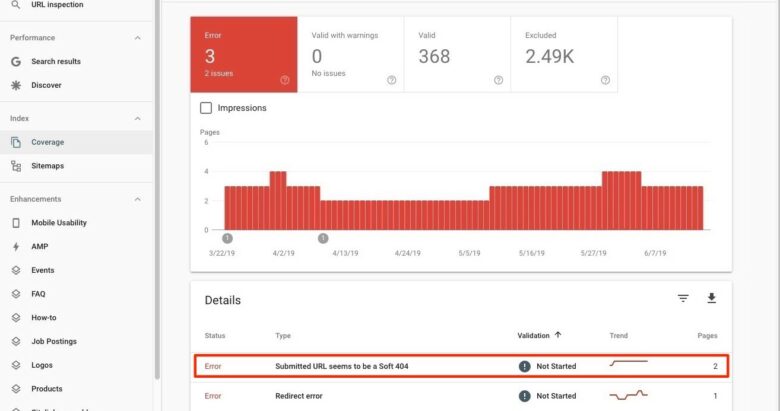
Another way is to launch an URL checking. The URL Inspection tool is available on the main page of your admin dashboard.

And finally, you can get the report by visiting Settings – Stats crawl reports. Here you find the Crawl requests breakdown reports. Choose By Response and pick the “Not found” one.
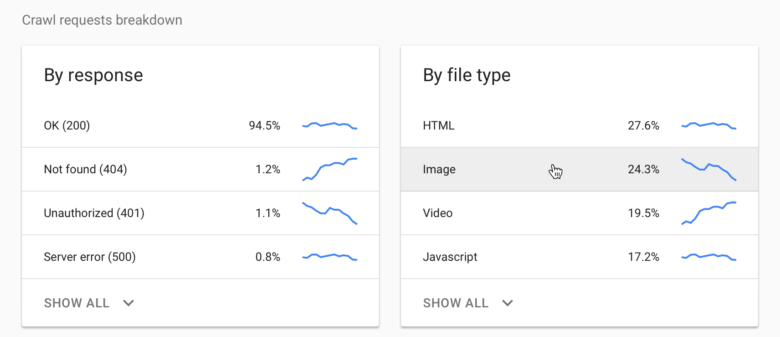
2. Screaming Frog
To get started with Screaming Frog, you need to download and install the program on your computer. Then, in the window that pops up, enter your website’s URL. The program will display a list of problems.
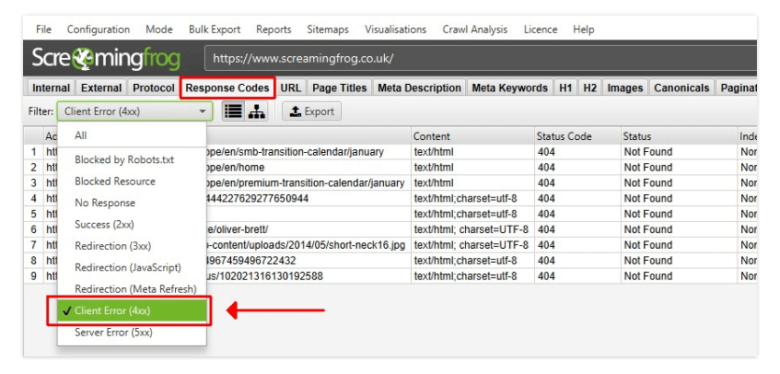
2. Ubersuggest
Ubersuggest the SEO tool of renowned marketer and entrepreneur Neil Patel.
Go to the SEO Explorer tab and choose the SEO Analyzer tool. Type in your website URL and wait ~10 minutes until the tool scans your inventory. Then, examine the Critical Errors report.
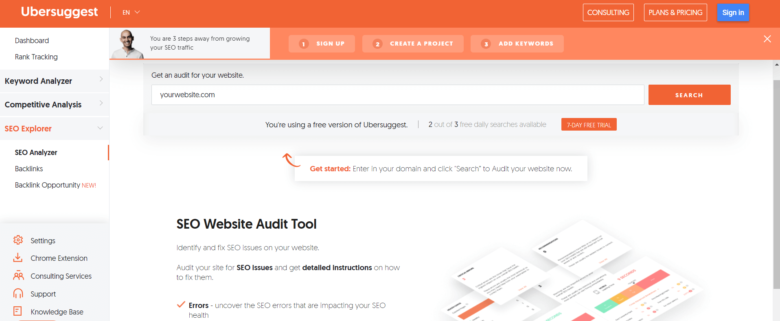
3. Dead Link Checker
Dead Link Checker is a simple and fast web application for finding 404 error pages. You can check both a specific page and the entire site. To start testing, you just need to enter the URL of your website and launch the application. The program will provide you with a list of error pages.

4. Google Analytics
You can also use Google Analytics to track 404 pages. That’s an easy though not very sharp means. From Google Analytics, open “Behavior”, then “Site Content”, then “All Pages”. Click the “Page Title” tab and enter “404” in the search bar. You will get a report containing all pages with 404 title and see how many visitors didn’t found what they were looking for.

4. MonsterInsights
If you have a WordPress site, install the MonsterInsights plugin. It will automatically track your 404 errors as soon as you open Google Analytics.

How to fix 404 error codes
After locating all your 404 errors, you need to learn to fix them. Let’s take a look at how to fix the most common ones.
1. The link leads nowhere
Such a situation can arise when the page has been assigned the wrong address. How to solve this issue? You need to find the page and attach the correct link to it. This can be done manually if we’re not talking about a lot of pages, or with the help of widgets. They will automatically generate links for pages.
2. The link goes to a deleted page
This problem is connected to pages getting internally re-interlinked. The webpage is long deleted, but the link to it remains. In this case, you can remove the link or direct it to another page. You can automate the process and set up internal linking using third-party programs and services.
Finding and fixing 404 errors on your WordPress site
How to remove a 404 error on a website created with CMS WordPress.
Fix .HTACCESS
In most cases, the problem lies in a missing .htaccess file. You need to create an empty text file with the “.htaccess” extension in the website’s root folder. Then, add standard WordPress directives to it.
# BEGIN WordPress
<IfModule mod_rewrite.c>
RewriteEngine On
RewriteBase /
RewriteCond %{REQUEST_FILENAME} !-f
RewriteCond %{REQUEST_FILENAME} !-d
RewriteRule . /index.php [L]
</IfModule>
# END WordPress
Fix your permalink structure
- Log in to your WordPress Admin panel.
- In the left menu click “Settings.”
- Go to “Permalinks.”
- If you are using a custom permalink structure, copy and save them in any text editor.
- Select the default value.
- Click “Save settings.”
- Change the settings back to what they previously were (before selecting Default).
- Return the custom structure if you had one.
- Click “Save settings.”

Set up redirects for pages with changed URLs
Setting up WordPress redirects allows search engines to index websites’ new URLs while deleting old ones.
But only certain HTTP redirect codes will let you maintain your search engine rankings. You can read more about these redirection codes in this article.
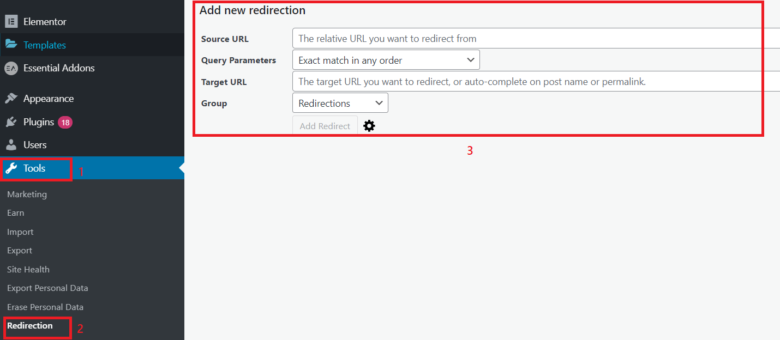
When all errors are found and fixed, it’s about time to make your WordPress website bring profits. Learn all is and outs on how to make money with Adsterra ad formats.
How often should you check for 404 error codes to fix them?
Check your website for 404 errors each month if you have a small website (around 50 pages). If the number of pages exceeds 50, then you should perform this little “check-up” every week. Checking for technical pitfalls won’t eat up too much time, but it will save customers, as well as preserve the website’s search engine rating.
Why personalize your 404 error page?
Clicking on a broken link is always annoying – on the other side only broken dreams and irritation await the user. And worst of all – that may have been your potential buyer, who could’ve turned into a loyal and regular customer.
No matter how hard you try, from time to time your users will get the 404 error message. You are very unlikely to get rid of this issue altogether. But are there perhaps ways to sugar-cover the bitter truth?
If the problem cannot be avoided, then we must try to turn it into a useful tool that will convert such mistakes into buyers. How?
- Retain the user’s attention on a non-standard situation.
- Present the error as an annoying misunderstanding.
- Say that the good news is that the required information is probably on the website.
- Offer simple and understandable alternatives.
The most important thing is to reject the faceless standard 404 error page that does nothing but state the irritating fact, leaving the client with no other choice but to just close the page.
Don’t disappoint your customers. Create your own unique personalized page. In accordance with the recommendations of search engines, the 404 page should fit into the overall concept of the website’s design. It should be a continuation and addition of it.
Things you can place on the 404 error page
Popular CMSs make it possible to add various website elements on the 404 pages:
- home page links;
- links to the website’s best content;
- sitemaps;
- search forms;
- feedback forms;
- catalog categories;
- lead generation or subscription forms.
Why you need a unique 404 page for your website
First of all, to retain a potential client, help them find the info they’re looking for, strengthen the brand, calm the user’s irritation, add a little humor to the situation, etc.
Here are some good examples of 404 pages used by popular brands.
Disney
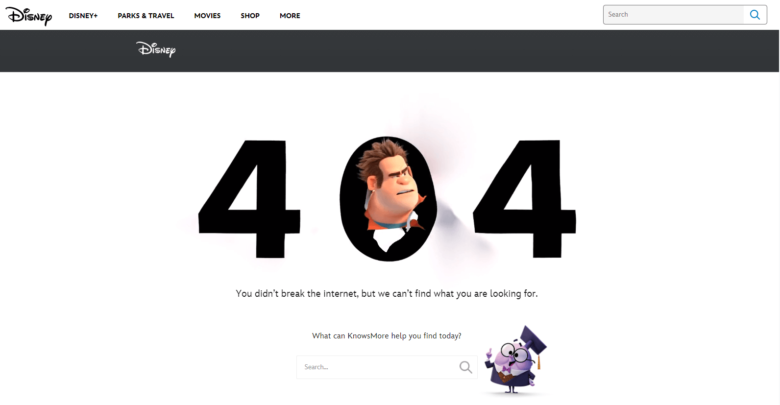
Amazon
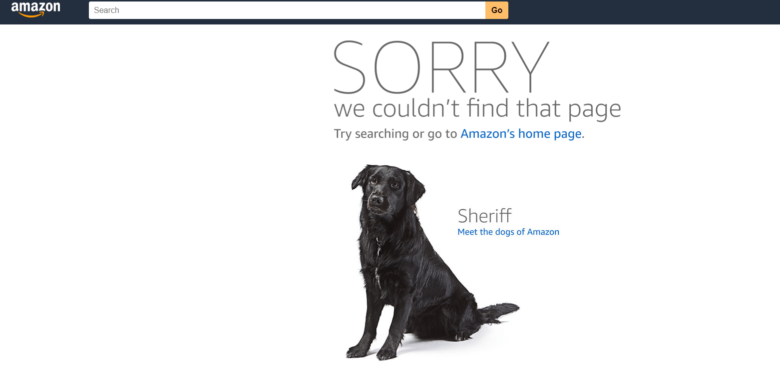
Magento
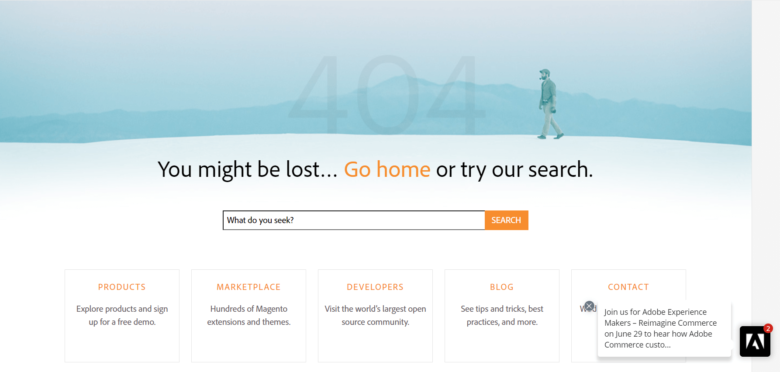
Conclusion
To end off this article in a more practical manner, with a few more tips:
- Avoid using long and complicated page titles.
- Keep URLs unchanged. Try not changing URLs too often as it confuses the user, search bots and you as well.
- Choose reliable hosting services. By doing so you’ll save yourself a lot of trouble.
404 errors are inevitable. Use these recommendations and tools, conduct regular checks to find and fix these errors, and they won’t get the chance to do any damage.
Improving a website is an ongoing mission, but you can start earning on traffic any moment. Adsterra is known for the fastest website approval and high payouts for publishers. Join the community of passionate pros!

